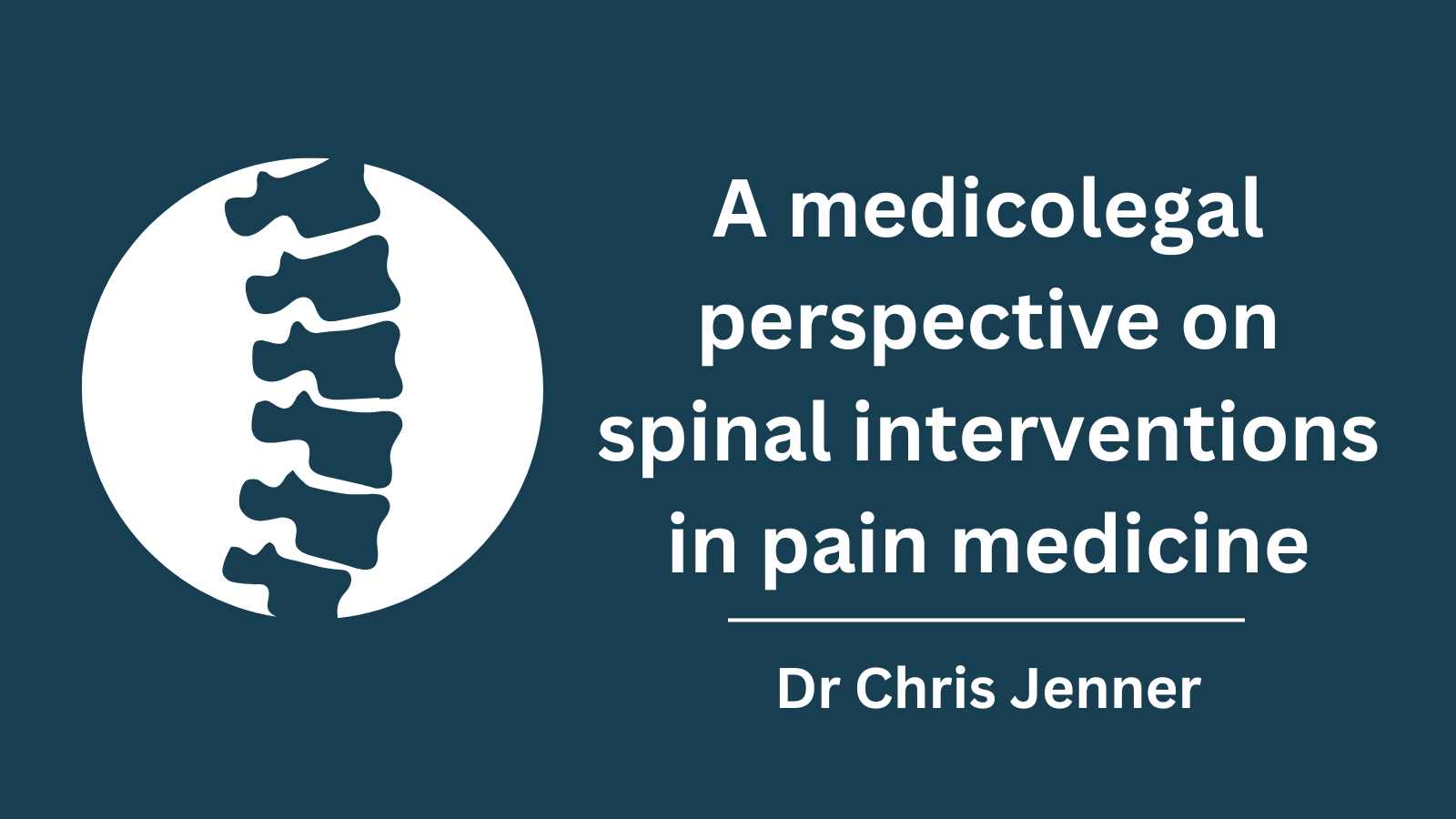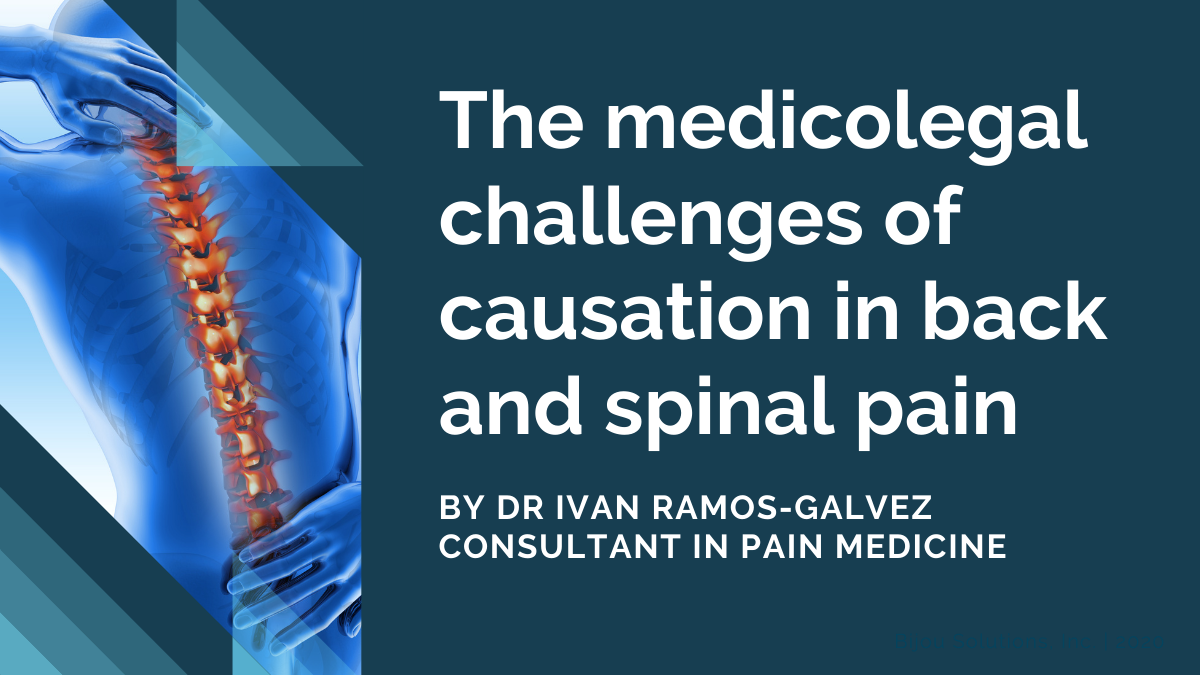A medicolegal perspective on spinal interventions in pain medicine

Back pain affects up to 80% of the population at some point during their lifetime and is one of the commonest reasons to visit the GP. Many patients make a full recovery within a few weeks, but some are left with chronic pain, and finding effective relief is difficult. For these patients, a range of treatments, collectively known as interventional pain management, may be particularly useful. While a multidisciplinary approach, utilising the skills of a range of practitioners, can be used, the mainstay of this form of treatment involves the administration of minimally invasive techniques to the spinal area.
Surgical treatment options are effective for a number of conditions that give rise to chronic back pain, but the selection of suitable patients for surgery can be challenging and the results variable. Many patients may instead benefit from minimally invasive injection treatments, particularly those for whom surgery is not strongly indicated, is contra-indicated due to the presence of existing comorbidities or advanced age, or for patients who cannot tolerate oral pain medication at a dose appropriate to control their condition. Any patient with a history of back pain for at least 6 weeks that has not responded to conservative treatment, or who is significantly debilitated or unable to participate fully in rehabilitation due to pain, should be considered for intervention, particularly as a major aim of this type of therapy is to alleviate pain for long enough to allow the patient to engage in rehabilitation techniques aimed at providing longer term relief.
One of the most commonly used spinal intervention technique is facet joint injection. This is used to both diagnose and manage facet joint pain. Facet joints are found along the entire length of the spine, with the size and shape of the joint depending on the vertebral level. Pain in these joints is extremely common and may account for around half of all cases of neck, thoracic and lower back pain. It is most frequently caused by degenerative changes to the bony surfaces, but may also be associated with rheumatoid arthritis, ankylosing spondylitis and septic arthritis. Diagnosis of facet joint pain can be difficult due to the non-specific findings on physical examination and imaging, which may overlap with other pain pathologies. While scans may show evidence of degenerative changes, often they appear completely normal. Patients with this condition present with pain in various areas, including the neck and back, and may also complain of pain that worsens with hyperextension, lateral bending and rotation.
Therefore, the introduction of local anaesthetic into the facet joint capsule can be a reliable diagnostic indicator, if it provides temporary symptom relief. If diagnostic injections show that the facet joint is indeed the source of the patient’s pain, therapeutic injections are indicated, usually as an adjunct to other conservative methods of pain management. The only absolute contraindication is patient refusal, but care should be taken in patients with infections over the injection site, blood clotting problems or susceptibility to excessive bleeding, allergies to the contrast agent or medications, or neurological disorders that may be masked by the procedure. It is also important that the patient is made aware that the pain relief resulting from facet joint injections is variable and that repeated injections may be needed.
Where facet joint injections are successful in the short term, longer-lasting pain relief can be obtained through the use of radiofrequency ablation. Therefore, it is particularly suited to patients with chronic pain. This procedure should only be carried out after a positive diagnostic block has confirmed the facet joint as the origin of the pain. In this technique, a heated radiofrequency tip is used to coagulate the nerve, leaving it unable to transmit pain signals. It can provide significant pain relief for a period of several years. However, some patients do experience recurrent pain after ablation procedures and require a repeat treatment. It is likely that this recurrence is due to neural rerouting around the facet joint, rather than a failure of the primary procedure. Patients who completely fail to respond to a first treatment are unlikely to obtain pain relief on repeat procedures, but in those who experience good pain control for at least 3 months, a second ablation is highly likely to be successful.
Major complications from these spinal intervention techniques are extremely rare, particularly when imaging is used to guide needle placement, and are normally only seen in older patients with existing underlying risk factors. Less severe complications include haematoma, nerve root irritation, bruising and soreness. These tend to last only a short period of time, after which they resolve spontaneously. Several side effects, such as vertebral artery damage and phrenic nerve palsy, are restricted to procedures carried out in the neck region and for this reason, injections in this area are less commonly performed.
Spinal intervention techniques provide safe and effective management of refractory back pain and are well-tolerated in most patients. The choice of technique should be guided by the clinical history. Complications are rare and can be minimised further by strict adherence to the proper technique, combined with the use of imaging guidance for needle placement.
Further reading:
Eseonu, K., Panchmatia, J., Pang, D., & Fakouri, B. (2021). A Review of the Clinical Utility of Therapeutic Facet Joint Injections in Whiplash Associated Cervical Spinal Pain. Spine surgery and related research, 6(3), 189–196. https://doi.org/10.22603/ssrr.2021-0180
Le, D. T., & Alem, N. (2022). Facet Joint Injection. In StatPearls. StatPearls Publishing.




